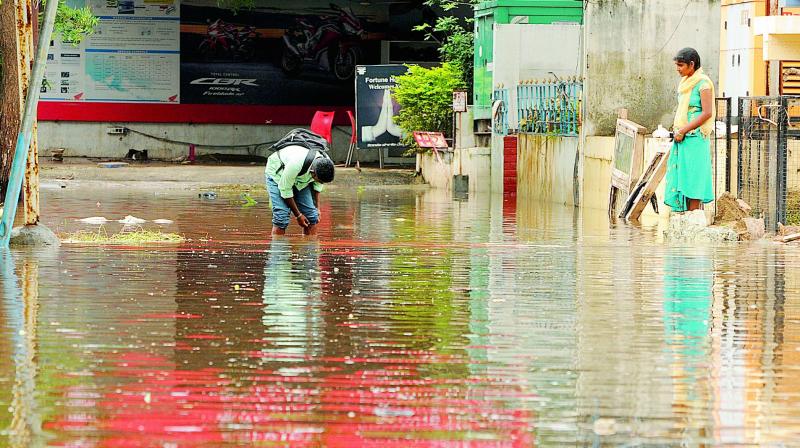Nizam era drains keep Old City dry

Hyderabad: The century-old storm water drain system of the Nizam era has proven that even now it is much better than the modern drainage system. Old mohallas of Hyderabad are not much affected by the recent continuous rain. Rainwater only entered houses in areas colonised after 1960.
When the Musi River was flooded in 1908, the sixth Nizam, Mir Mahboob Ali Khan, appointed Mokshag-ondam Vishweshwarayya as chief adviser to avoid such havoc in future and focus on the draining of storm water. He asked him to study Hyderabad and chalk out an elaborate plan to manage the floods and for storm water management.
After his demise in 1911, the seventh Nizam, Mir Osman Ali Khan, established the City Improvement Board to provide better civic facilities in the city. Later, the City Drainage Board was established in 1926.
The system is still serving efficiently despite a manifold increase in the population. During the recent incessant rain, it survived the severe force of the water. Old mohallas like Moghalpura, Khilwat, Fateh Darwaza, Chelapura, Hussaini Al-am, Sultan Shahi and Chanchalguda are areas never affected during heavy rains. In these areas, rainwater recedes in lesser time as the lines of the storm water drains and drainage drains are much deeper and wider compared with lines developed after the Nizam era.
In the Old City, only those habitations were being affected during the rain which came up either on water bodies or on the banks of nalas. Such areas include Talabkatta, Ganga Bowli, Bhavani Nagar, Salam Chowk, Falaknuma Al-Jubail Colony, Bilalnagar, Amannagar, Moula Ka Chilla.
New colonies which emerged in Tolichowki like Nizam Colony, Salar Jung Colony, MD Lines, Nadeem Colony, Al-Hasnat Colony, Al-Kareem Colony, Owaisi Colony, Akbarpura, Balreddyn-agar are most affected areas which are inundated every year.
Residents complained that the GHMC authorities do not de-silt the Balkampet nala passing through the military area.
Dr Gade Venkatesh, a sanitation expert, said Asaf Jahi rulers were keen to acquire world class facilities in their estate and always focused on high quality. Whatever they built and developed were the world’s best standards of their times. The effective working of that system shows the great vision of the Nizam who had planned keeping in mind the manifold increase in the population.
He said for effective control of drain water in the state capital, there is a need to re-design and re-vamp the drain system taking into account the future population, as the city is expanding rapidly and vastly. At present, the length of the drain canals is about 1,600 kms, which should be extended up to 5,000 kms and for that we have to have 1,1300 more manholes..
Citizens demand permanent relief
Concerned citizens of the twin cities have harked back to the 111th Anniversary of Musi Floods while demanding a master plan for a drainage system that ensures that Hyderabad and its environs are free of any rain havoc in the future.
To mark the 111th anniversary, Forum for Better Hyderabad organised a “Memorial and Solidarity Meet” under the Tamarind Tree in Afzal Park, Osmania Hospital, which saved 150 lives during the Musi floods.
President of the Forum M. Ved Kumar said after the floods in Musi River, VII Nizam Mir Osman Ali Khan developed the underground drainage system utilising the services of great city planners Mokshagundam Vishw-eshwarayya and Ali Nawaz Jung. That drainage system is still working efficiently.
He said “If we want Hyderabad to be a clean and green city, we have to make Musi River clean and manage it in a systematic manner. Unless we do that, we cannot solve the problem of floods, as every nala of the city drains into the Musi.”
Ved Kumar underlined that to have a well-designed master plan for drainage, civil society will have to play a key role.
“The government has established the Musi River Front Development Corporation. We hope the government will take the initiative in quickly developing a systematic drainage system. To promote this cause, we have also established a group ‘Friends of Musi River’,” the forum president stated.
Mohammed Safiullah of the forum suggested that school syllabi should include the services of Kakatiya, Qutub Shahi and Asif Jahi rulers to the Hyderabad state. This will let them know the feats of our past rulers. We are still utilising the structures and infrastructure created by Asif Jahi rulers, he pointed out.
Others who participated in the meeting are Anand Raj Verma, Professor Anwar Khan, Ashfaq Hussain of CHATRI, Sangamitra Malik, and poets Bedhadak Madrasi and Munawar Ali Mukhtasar.

